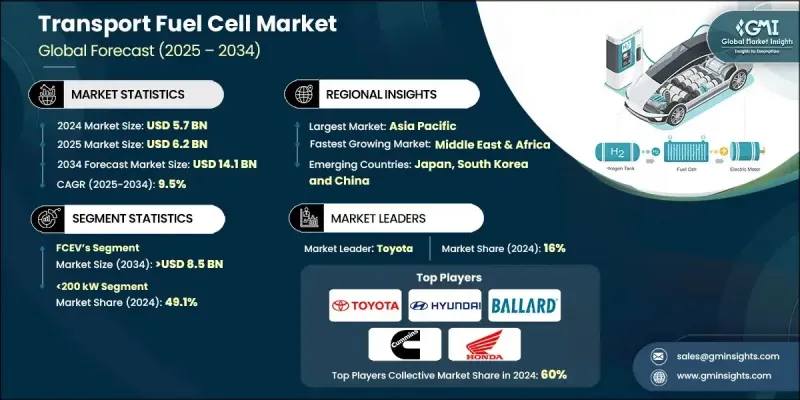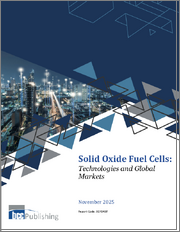
|
시장보고서
상품코드
1859024
운송용 연료전지 시장 기회, 성장 촉진요인, 산업 동향 분석 및 예측(2025-2034년)Transport Fuel Cell Market Opportunity, Growth Drivers, Industry Trend Analysis, and Forecast 2025 - 2034 |
||||||
세계의 운송용 연료전지 시장 규모는 2024년에 57억 달러로 평가되었고, CAGR 9.5%를 나타내 2034년에는 141억 달러에 이를 것으로 예측되고 있습니다.

이 성장 궤도는 세계적인 운송 네트워크에서 탈탄소화와 청정 에너지 도입의 추진이 증가하고 있는 것에 뒷받침되고 있습니다. 내구성 향상, 비용 최적화, 효율 개선 등 최신 연료전지 시스템의 성능 지표가 강화됨에 따라 연료전지는 다양한 운송 용도에 선호되는 솔루션이 되고 있습니다. 수소 인프라가 계속해서 성숙하고 주요 경제국의 국가 수소 목표가 전개되고 있는 가운데, 연료전지의 실현 가능성은 급속히 확대되고 있습니다. 모빌리티 부문 전체의 배출량 감소에 초점을 맞춘 정부의 의무는 제로 방출 솔루션으로의 대규모 이동을 촉진하고 있으며, 연료전지는 특히 대형, 장거리, 오프 그리드 용도에서 강력한 대안을 제공합니다. 이 시스템은 전기 모터에 전력을 공급하기 위해 발전하고 연소 엔진과 같은 안정적인 출력 성능을 발휘하면서 꼬리 파이프 배출을 제거합니다. 분명한 기세에도 불구하고, 시장은 여전히, 특히 성숙도가 낮은 지역에서는 선행 투자 비용의 높이, 가혹한 조건 하에서의 운영 신뢰성 문제, 수소 물류의 미정비와 싸우고 있습니다. 그러나 현재 진행중인 투자와 관민 파트너십은 이러한 제약을 완화하고 세계적인 접근성을 높이기 위해 노력하고 있습니다.
| 시장 범위 | |
|---|---|
| 시작 연도 | 2024년 |
| 예측 연도 | 2025-2034년 |
| 시작 금액 | 57억 달러 |
| 예측 금액 | 141억 달러 |
| CAGR | 9.5% |
철도분야는 여객수송과 화물운송 모두에서 연료전지 이용이 증가하고 있는 것을 배경으로 2034년까지 연평균 복합 성장률(CAGR) 9.5%를 나타낼 전망입니다. 연료전지를 동력원으로 하는 열차는 전기가 지연되고 있는 철도망으로 배출가스를 배출하지 않는 운행을 가능하게 해, 인프라 비용을 최소한으로 억제해, 유지관리의 경감과 조용한 서비스를 제공합니다. 이 기술은 지속 가능한 리노베이션이 필요한 광대 한 철도망을 가진 국가에서 특히 매력적입니다.
용량 200kW-1MW의 연료전지는 2024년에 34.7%의 점유율을 차지했고 2034년까지 연평균 복합 성장률(CAGR) 8.5%를 나타낼 것으로 예측됩니다. 이 출력 대역은 중형 상용차, 화물용 기관차, 중형 선박에 이상적입니다. 에너지 출력, 시스템의 복잡성 및 비용의 균형을 맞추기 때문에 많은 실제 수송 용도에 이상적입니다.
유럽의 운송용 연료전지 시장은 유럽 그린딜 정책과 수소 인프라에 대한 대규모 투자의 영향을 받아 2034년까지 30억 달러에 이를 것으로 예측됩니다. 이 지역에서는 철도 용도로의 도입이 활발하고 선박 시스템에서의 이용이 확대되고 있습니다. 독일, 노르웨이, 네덜란드 등의 국가들은 연료전지 운송의 혁신을 적극적으로 형성하고 있으며, 전체 제품 수요와 인프라 지원을 뒷받침하고 있습니다.
세계 운송용 연료전지 시장의 주요 기업으로는 Toyota Motor Corporation, Ballard Power Systems, Hyundai Motor Company, Honda Motor, BorgWarner Inc., Doosan Fuel Cell, Intelligent Energy Limited, ZF Friedrichshafen AG, Freudenberg, PowerCell Sweden, Elring Klinger, AISIN Cells, AFC Energy PLC, Cumins, Wuhan Tiger Fuel Cell, Toshiba Corporation, Nedstack Fuel Cell Technology 등이 있습니다. 운송용 연료전지 업계의 지위를 강화하기 위해, 주요 기업은 연료전지 시스템의 효율과 라이프사이클을 향상시키는 연구개발에 많은 투자를 하고 있습니다. 많은 기업들이 자동차 제조업체나 철도 제조업체와 제휴해, 자사의 기술을 상용차나 차량에 임베디드하려고 하고 있습니다. 세계적인 수요에 대응하고 공급망의 마찰을 줄이기 위해 생산 능력을 확대하고 지역적인 제조 허브를 구축하고 있는 기업도 있습니다.
자주 묻는 질문
목차
제1장 조사 방법과 범위
제2장 주요 요약
제3장 업계 인사이트
- 업계 에코시스템
- 규제 상황
- 업계에 미치는 영향요인
- 성장 촉진요인
- 업계의 잠재적 리스크 및 과제
- 성장 가능성 분석
- 가격 동향 분석(2021-2034년)
- 최종 용도별
- 지역별
- Porter's Five Forces 분석
- PESTEL 분석
제4장 경쟁 구도
- 서론
- 기업의 시장 점유율 분석 : 지역별
- 북미
- 유럽
- 아시아태평양
- 중동 및 아프리카
- 라틴아메리카
- 전략적 대시보드
- 전략적 노력
- 기업 벤치마킹
- 파괴적 혁신 기술 정세
제5장 시장 규모와 예측 : 제품별(2021-2034년)
- 주요 동향
- PEMFC
- SOFC
- DMFC
- PAFC 및 AFC
- MCFC
제6장 시장 규모와 예측 : 용량별(2021-2034년)
- 주요 동향
- 200kW 이하
- 200kW-1MW
- 1MW 이상
제7장 시장 규모와 예측 : 최종 용도별(2021-2034년)
- 주요 동향
- 해상
- 철도
- FCEV
- 기타
제8장 시장 규모와 예측 : 지역별(2021-2034년)
- 주요 동향
- 북미
- 미국
- 캐나다
- 유럽
- 독일
- 영국
- 프랑스
- 이탈리아
- 스페인
- 오스트리아
- 아시아태평양
- 일본
- 한국
- 중국
- 인도
- 필리핀
- 베트남
- 중동 및 아프리카
- 남아프리카
- 아랍에미리트(UAE)
- 사우디아라비아
- 라틴아메리카
- 브라질
- 페루
- 멕시코
제9장 기업 프로파일
- AISIN Corporation
- AFC Energy PLC
- BorgWarner Inc
- Ballard Power Systems
- Cummins
- Doosan Fuel Cell
- ElringKlinger
- Freudenberg
- Hyundai Motor Company
- Honda Motor
- Intelligent Energy Limited
- Nuvera Fuel Cells
- Nedstack Fuel Cell Technology
- PowerCell Sweden
- Oorja Fuel Cells
- Symbio
- Toyota Motor Corporation
- Toshiba Corporation
- Wuhan Tiger Fuel Cell
- ZF Friedrichshafen AG
The Global Transport Fuel Cell Market was valued at USD 5.7 billion in 2024 and is estimated to grow at a CAGR of 9.5% to reach USD 14.1 billion by 2034.

This growth trajectory is fueled by the rising push for decarbonization and clean energy adoption across global transportation networks. Enhanced performance metrics in modern fuel cell systems, such as improved durability, cost optimization, and better efficiency, are making them a preferred solution in various transport applications. As hydrogen infrastructure continues to mature and national hydrogen targets are being rolled out by leading economies, the viability of fuel cells is expanding rapidly. Government mandates focused on slashing emissions across the mobility sector are prompting a large-scale shift toward zero-emission solutions, where fuel cells offer a strong alternative, particularly for heavy-duty, long-haul, and off-grid applications. These systems generate electricity to power electric motors, eliminating tailpipe emissions while delivering consistent output performance like combustion engines. Despite clear momentum, the market still contends with high upfront capital costs, operational reliability issues in extreme conditions, and underdeveloped hydrogen logistics, particularly in less mature regions. However, ongoing investment and public-private partnerships are working to mitigate these constraints and enhance global accessibility.
| Market Scope | |
|---|---|
| Start Year | 2024 |
| Forecast Year | 2025-2034 |
| Start Value | $5.7 Billion |
| Forecast Value | $14.1 Billion |
| CAGR | 9.5% |
The railway segment will grow at a CAGR of 9.5% through 2034, driven by the increasing use of fuel cells in both passenger and freight transport. These fuel cell-powered trains enable emission-free operations on rail networks lacking electrification, minimizing infrastructure costs and offering lower maintenance and quieter service. The technology is proving especially attractive in countries with vast rail networks needing sustainable retrofitting.
The fuel cells in the 200 kW to 1 MW capacity segment held a 34.7% share in 2024 and are projected to grow at an 8.5% CAGR through 2034. This power band is ideally suited for medium-duty commercial fleets, freight locomotives, and mid-sized marine vessels. It strikes a balance between energy output, system complexity, and cost, making it optimal for many real-world transport applications.
Europe Transport Fuel Cell Market is expected to reach USD 3 billion by 2034, influenced by the European Green Deal and heavy investment in hydrogen infrastructure. The region is witnessing strong deployment in rail applications and growing uptake in marine systems. Countries including Germany, Norway, and the Netherlands are actively shaping fuel cell transportation innovation, boosting overall product demand and infrastructure support.
Leading companies in the Global Transport Fuel Cell Market include Toyota Motor Corporation, Ballard Power Systems, Hyundai Motor Company, Honda Motor, BorgWarner Inc., Doosan Fuel Cell, Intelligent Energy Limited, ZF Friedrichshafen AG, Freudenberg, PowerCell Sweden, ElringKlinger, AISIN Corporation, Symbio, Nuvera Fuel Cells, Oorja Fuel Cells, AFC Energy PLC, Cummins, Wuhan Tiger Fuel Cell, Toshiba Corporation, and Nedstack Fuel Cell Technology. To strengthen their position in the transport fuel cell industry, key players are heavily investing in research and development to enhance the efficiency and lifecycle of their fuel cell systems. Many companies are forming partnerships with automotive and rail manufacturers to integrate their technologies into commercial vehicles and fleets. Several firms are scaling up production capacity and regional manufacturing hubs to support global demand and reduce supply chain friction.
Table of Contents
Chapter 1 Methodology & Scope
- 1.1 Research design
- 1.1.1 Research approach
- 1.1.2 Data collection methods
- 1.1.3 Base estimates and calculations
- 1.1.4 Base year calculation
- 1.1.5 Key trends for market estimates
- 1.2 Forecast model
- 1.3 Primary research & validation
- 1.3.1 Primary sources
- 1.4 Data mining sources
- 1.5 Market definitions
Chapter 2 Executive Summary
- 2.1 Industry 3600 synopsis, 2021 - 2034
- 2.2 Business trends
- 2.3 Product trends
- 2.4 Capacity trends
- 2.5 End use trends
- 2.6 Regional trends
Chapter 3 Industry Insights
- 3.1 Industry ecosystem
- 3.2 Regulatory landscape
- 3.3 Industry impact forces
- 3.3.1 Growth drivers
- 3.3.2 Industry pitfalls & challenges
- 3.4 Growth potential analysis
- 3.5 Price trend analysis, 2021-2034
- 3.5.1 By end use
- 3.5.2 By region
- 3.6 Porter's analysis
- 3.6.1 Bargaining power of suppliers
- 3.6.2 Bargaining power of buyers
- 3.6.3 Threat of new entrants
- 3.6.4 Threat of substitutes
- 3.7 PESTEL analysis
Chapter 4 Competitive landscape, 2025
- 4.1 Introduction
- 4.2 Company market share analysis, by region, 2024
- 4.2.1 North America
- 4.2.2 Europe
- 4.2.3 Asia Pacific
- 4.2.4 Middle East & Africa
- 4.2.5 Latin America
- 4.3 Strategic dashboard
- 4.4 Strategic initiatives
- 4.5 Company benchmarking
- 4.6 Innovation & technology landscape
Chapter 5 Market Size and Forecast, By Product, 2021 - 2034 (USD Million & MW)
- 5.1 Key trends
- 5.2 PEMFC
- 5.3 SOFC
- 5.4 DMFC
- 5.5 PAFC & AFC
- 5.6 MCFC
Chapter 6 Market Size and Forecast, By Capacity, 2021 - 2034 (USD Million & MW)
- 6.1 Key trends
- 6.2 <200 kW
- 6.3 200 kW - 1 MW
- 6.4 ≥ 1 MW
Chapter 7 Market Size and Forecast, By End Use, 2021 - 2034 (USD Million & MW)
- 7.1 Key trends
- 7.2 Marine
- 7.3 Railways
- 7.4 FCEVs
- 7.5 Others
Chapter 8 Market Size and Forecast, By Region, 2021 - 2034 (USD Million & MW)
- 8.1 Key trends
- 8.2 North America
- 8.2.1 U.S.
- 8.2.2 Canada
- 8.3 Europe
- 8.3.1 Germany
- 8.3.2 UK
- 8.3.3 France
- 8.3.4 Italy
- 8.3.5 Spain
- 8.3.6 Austria
- 8.4 Asia Pacific
- 8.4.1 Japan
- 8.4.2 South Korea
- 8.4.3 China
- 8.4.4 India
- 8.4.5 Philippines
- 8.4.6 Vietnam
- 8.5 Middle East & Africa
- 8.5.1 South Africa
- 8.5.2 UAE
- 8.5.3 Saudi Arabia
- 8.6 Latin America
- 8.6.1 Brazil
- 8.6.2 Peru
- 8.6.3 Mexico
Chapter 9 Company Profiles
- 9.1 AISIN Corporation
- 9.2 AFC Energy PLC
- 9.3 BorgWarner Inc
- 9.4 Ballard Power Systems
- 9.5 Cummins
- 9.6 Doosan Fuel Cell
- 9.7 ElringKlinger
- 9.8 Freudenberg
- 9.9 Hyundai Motor Company
- 9.10 Honda Motor
- 9.11 Intelligent Energy Limited
- 9.12 Nuvera Fuel Cells
- 9.13 Nedstack Fuel Cell Technology
- 9.14 PowerCell Sweden
- 9.15 Oorja Fuel Cells
- 9.16 Symbio
- 9.17 Toyota Motor Corporation
- 9.18 Toshiba Corporation
- 9.19 Wuhan Tiger Fuel Cell
- 9.20 ZF Friedrichshafen AG



















